 UK agriculture is running about a month behind last year at the moment, I am sure you will have noticed the slow start to the growing season. The appalling cold weather we have seen over the last month was the last thing any of our crops needed after such a wet and prolonged winter. A poor sowing season last autumn followed by the arctic conditions of much of April has been a bit of a double whammy. Let us not forget, the running annual total rainfall to the end of March was, and will hopefully remain, a record at 1680mm, or 67 inches in old money. This surpasses the previous record (March 2001) by 100mm (4 ins). The soils have been packed down hard by all the rain of the last year, and in order for them to dry out, we need them to warm up a bit, and for the crops too grow and draw moisture upwards by transpiration.
UK agriculture is running about a month behind last year at the moment, I am sure you will have noticed the slow start to the growing season. The appalling cold weather we have seen over the last month was the last thing any of our crops needed after such a wet and prolonged winter. A poor sowing season last autumn followed by the arctic conditions of much of April has been a bit of a double whammy. Let us not forget, the running annual total rainfall to the end of March was, and will hopefully remain, a record at 1680mm, or 67 inches in old money. This surpasses the previous record (March 2001) by 100mm (4 ins). The soils have been packed down hard by all the rain of the last year, and in order for them to dry out, we need them to warm up a bit, and for the crops too grow and draw moisture upwards by transpiration.
The cold weather has seriously complicated our decision making; such as when to apply fertilizer and various sprays. Normally we are well into the fungicide programme for the season by now, St George’s day is usually the time we give our wheats their second fungicide, whereas this year, many of our wheat crops have not yet even reached the stage needed for their first dose. I dare say at some point they will rapidly go through the growth stages, and will catch us napping, because you can be sure that by harvest time, we will be no more than a week adrift of the norm. We have had to tear up the calendar, which is usually a handy guide as to when to do what, and we will be adapting to the crop’s growth as we go along. We have already missed a great chunk of potential growing season by starting so late, so will be lucky if this does not affect our harvest. However, not wishing to be a doomsayer, the most important months for building yield will as usual be May, June and July, when we need sunshine for maximum photosynthesis.
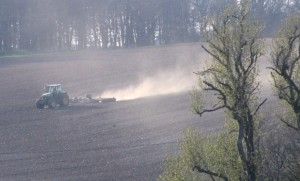 Today, at last, we managed to finish sowing our crops for the season, the final field of poppies was sown and rolled this afternoon. Already the first sown fields have emerged, having been sown before the recent wet weather. We have also managed to complete a significant amount of the fertilizer plan for most of our crops.
Today, at last, we managed to finish sowing our crops for the season, the final field of poppies was sown and rolled this afternoon. Already the first sown fields have emerged, having been sown before the recent wet weather. We have also managed to complete a significant amount of the fertilizer plan for most of our crops.
These two photographs of oilseed rape, taken on April 17th , show clearly the contrast between a vigorous variety which survived the winter well, and a poorer field, which still hasn’t managed to get going due to intensive attack by pigeons. 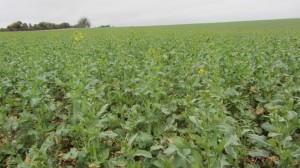
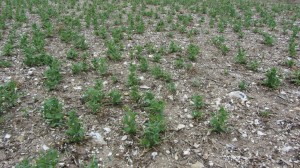 The winter wheat and barley look decidedly patchy in places, where waterlogging and slugs took their toll. The spring barley has now emerged after sitting in cold soil for weeks, and is moving only slowly.
The winter wheat and barley look decidedly patchy in places, where waterlogging and slugs took their toll. The spring barley has now emerged after sitting in cold soil for weeks, and is moving only slowly.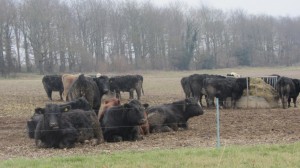
The cattle are all still indoors, we have had to buy in extra silage for them, as we ran out of our own several weeks ago, and they are going stir crazy, desperate to get back outside, however as there has been so little grass growth yet, we are not keen to let them puddle what little there is into mud. Our second to last calf was born at the weekend, so now there is just one cow remaining to produce, and she seems to be in no hurry. The bulls are still munching away, blissfully unaware that next month they will be expected to turn out for their annual 8 weeks hard work, all fit and raring to go.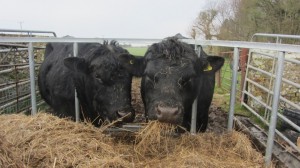
The sheep have been back on meagre pickings of grass since the turnips ran out last month, the ewes will be shorn in the next couple of weeks, and shortly after that hopefully will begin to lamb, so as usual, please could people exercise great care when walking on footpaths near sheep, especially when accompanied by dogs.
Some peculiar notices have appeared on road sides recently, erroneously informing people that shooting of badgers with high velocity bullets (!) will be occurring in the area soon, and that people should keep children, pets and themselves indoors. This is nothing but scaremongering of the worst order. Firstly, any badger culling that takes place as part of the government authorized culling scheme will not begin until June, and then only in Gloucestershire and Somerset. Dorset has been mentioned as a possible backup region, but there is so far no clue as to where in the county this might be even if it happens. Secondly, if badger culling were to take place locally, it would be by trained firearms license-holders, at night, with minimal risk to the public. A considerable amount of vermin shooting has always been undertaken at night over very many years in most country areas. The aim of the cull is to try to get some control over the terrible disease of tuberculosis in cattle, and which is spread widely by badgers. There is no other proven way of controlling the disease, which has been allowed to escalate to disastrous proportions since co-ordinated badger controls were abandoned more than 20 years ago. In those days, any TB outbreak was followed by strict action by the Ministry of Agriculture to contain the outbreak by culling infected badgers. This policy was largely effective, and only when the government lost its nerve in the face of the misguided animal rights movement, did the disease begin its tragic spread to the epic levels it exists at today. Increasingly stringent controls have been imposed on cattle farmers over recent years, to try to reduce levels of TB, with pitifully poor results. The bald fact is that unless steps are taken to control the disease in the wildlife, the disease will continue to spread across the country, costing millions and causing untold misery to farmers with affected animals.
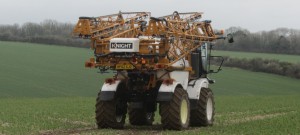
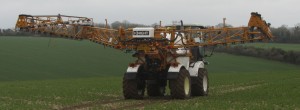

 Our new sprayer has been working hard over the last 10 days, and proving its worth. With a very early start on Saturday, we covered 56ha with fertiliser, and then moved on to spray the rape and covered 142ha by shortly after nightfall. This must be a record for the farm, just shy of 500 acres in one day for one man and his trusty machine. Over the last 10 days we have covered 862ha (2130 ac) with fert or spray or both. The lion’s share of nitrogen fertiliser has been applied for the season in that time, amounting to some 170,000 litres, approximately 8.5 lorry loads.
Our new sprayer has been working hard over the last 10 days, and proving its worth. With a very early start on Saturday, we covered 56ha with fertiliser, and then moved on to spray the rape and covered 142ha by shortly after nightfall. This must be a record for the farm, just shy of 500 acres in one day for one man and his trusty machine. Over the last 10 days we have covered 862ha (2130 ac) with fert or spray or both. The lion’s share of nitrogen fertiliser has been applied for the season in that time, amounting to some 170,000 litres, approximately 8.5 lorry loads.
Question: How do you know if that big white water bird is friendly, and simply after some bread, or whether he has his eye on your camera, or else that fleshy bit on the back of your arm?
Answer: You don’t!

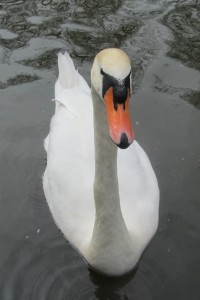
I always read your country diary with interest and often wry amusement. Your May blog however slipped in a rather polemic view of the badger debate. My understanding is that the current research, although not inconclusive, is more complicated than you have suggested. What many of your readers may not understand is: the lack of a bovine or badger vaccination when there is one for human TB, the passage of bovine from cattle to badger as well as vice versa and perhaps most importantly the huge cost paid by each UK citizen in compensating farmers (even inadequately) for the loss of stock. Perhaps a parallel might be hypothesised between hedgehogs, rarely seen but Beatrix Potter popular and cats, domesticated bird killers. If hedgehogs were believed to be infecting cats with say mange, and vice versa; where would the Daily Mail, tabloid of Middle England stand? Trapping hedgehogs or culling cats. Like all issues of any consequence the situation is complicated and decisions, like it or not, are not made entirely on rationality alone. Farmers have to realise, that fairly or not, they are seen to be responsible for a vast reduction in birds, butterflies and generally everything that was wonderful in the 1950’s.
The fact that as a result of increasing farm productivity food is now so ridiculously cheap, that we have more obesity than rickets is quietly forgotten. Sorry farmers, people believe what is convenient for them to believe and you have to present your argument with that in mind.
I enjoyed your enthusiastic response to the May issue of View from the Hill. If I may respond to a few of your points in the order in which you raised them:
I would also celebrate the introduction of a vaccine, for cows at least. The vaccination of badgers would seem to be an unnecessary and even cruel thing to inflict on them. If cattle were safely vaccinated, then tb could happily circulate amongst the badger population freely without bothering anyone else. The badgers could then suffer in peace from this miserable and debilitating disease, and their population would be self limiting. What many people fail to see from a culling policy, is that we would have a healthier, if slightly smaller, badger population.
Anyway, I understand from my scientist friends that a vaccine is still along way off, I have no idea why. There may also be EU regulations to get around, because a vaccine masks the presence or otherwise, of a notifiable disease.
It is most interesting that you should choose hedgehogs for your comparison, for there is a very strong body of opinion that cites the fact that there has been such a fall in hedgehog numbers due to predation by badgers! I saw my first hedgehog for many years just yesterday, it having been hit by a motor vehicle.
I was investigating another of the victims of old Brock only this morning, there is a small area of down land here which has been fenced off for at least 20 years, and there is a very striking difference between the number of anthills here, and on the open areas of down, where badgers have free access. I have photographic evidence of this contrast which I will no doubt be publishing soon. One can easily find evidence of anthills being dug into on the open download, but there are not many of them left now, I remember a great many more from my younger days.
Moving on to the birds and bees, it is commonly accepted that ground nesting birds have suffered the greatest decline in numbers where badgers are at their most numerous, and as you so wisely comment, farmers have had all the blame.
If you speak to a farmer of a closed dairy herd, ie one who breeds all his own replacements and brings no animals onto his holding, and who suffers repeated TB breakdowns due to the presence of it in the wildlife, what would you bid him do? Give up producing food, or control the problem until the wildlife is healthy?
So; cows, hedgehogs, ants and ground nesting birds, what else can we pin on the stripy faced fellow? Well I did hear of a story involving a baby being carried off into the brambles by a salivating scabby individual with black and white striped facial hair, but I suppose that could have been a relative.
The original comment has been edited, as it also raised further areas of debate that the website author doesn’t feel robust enough to publish at the moment.